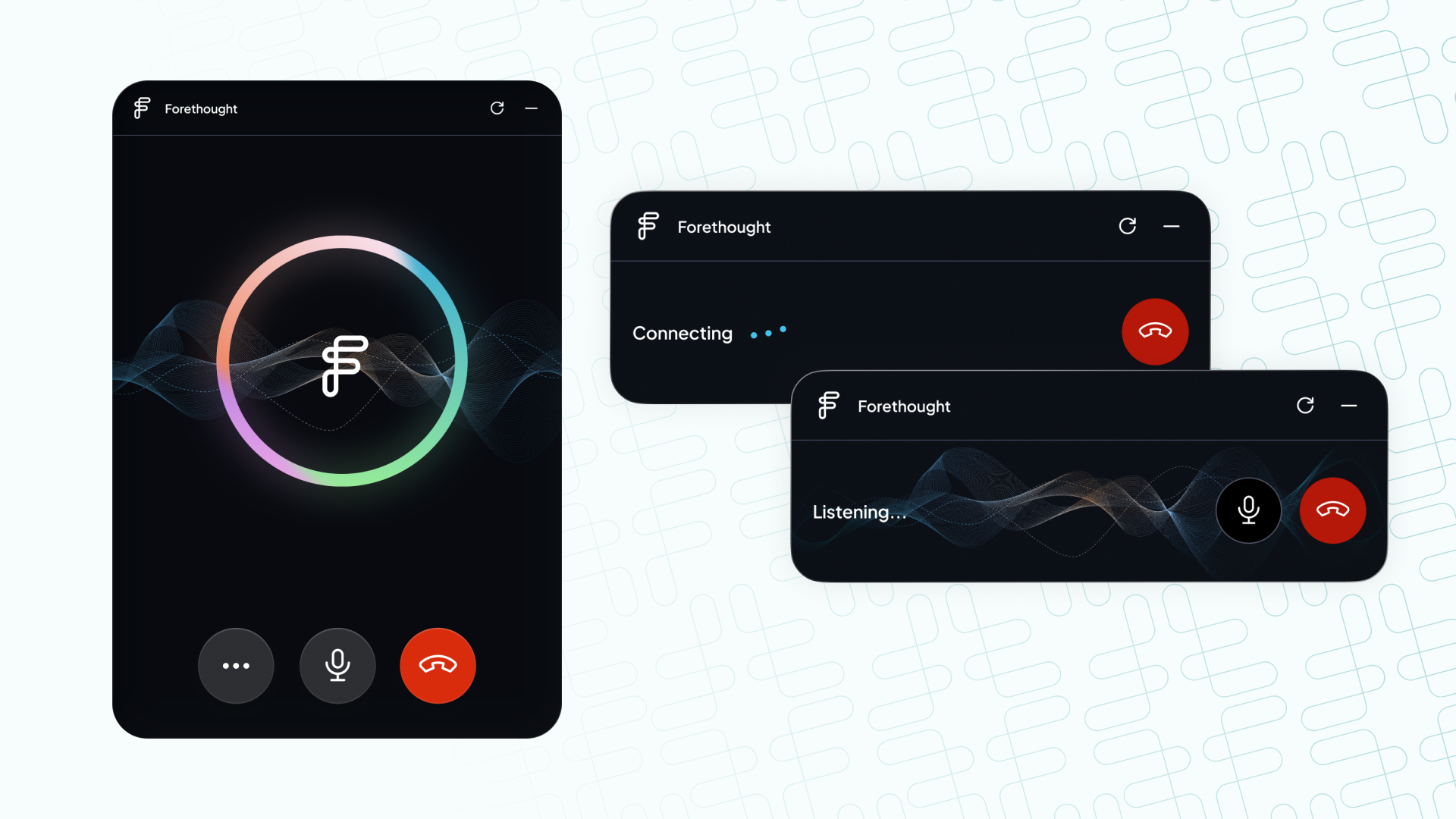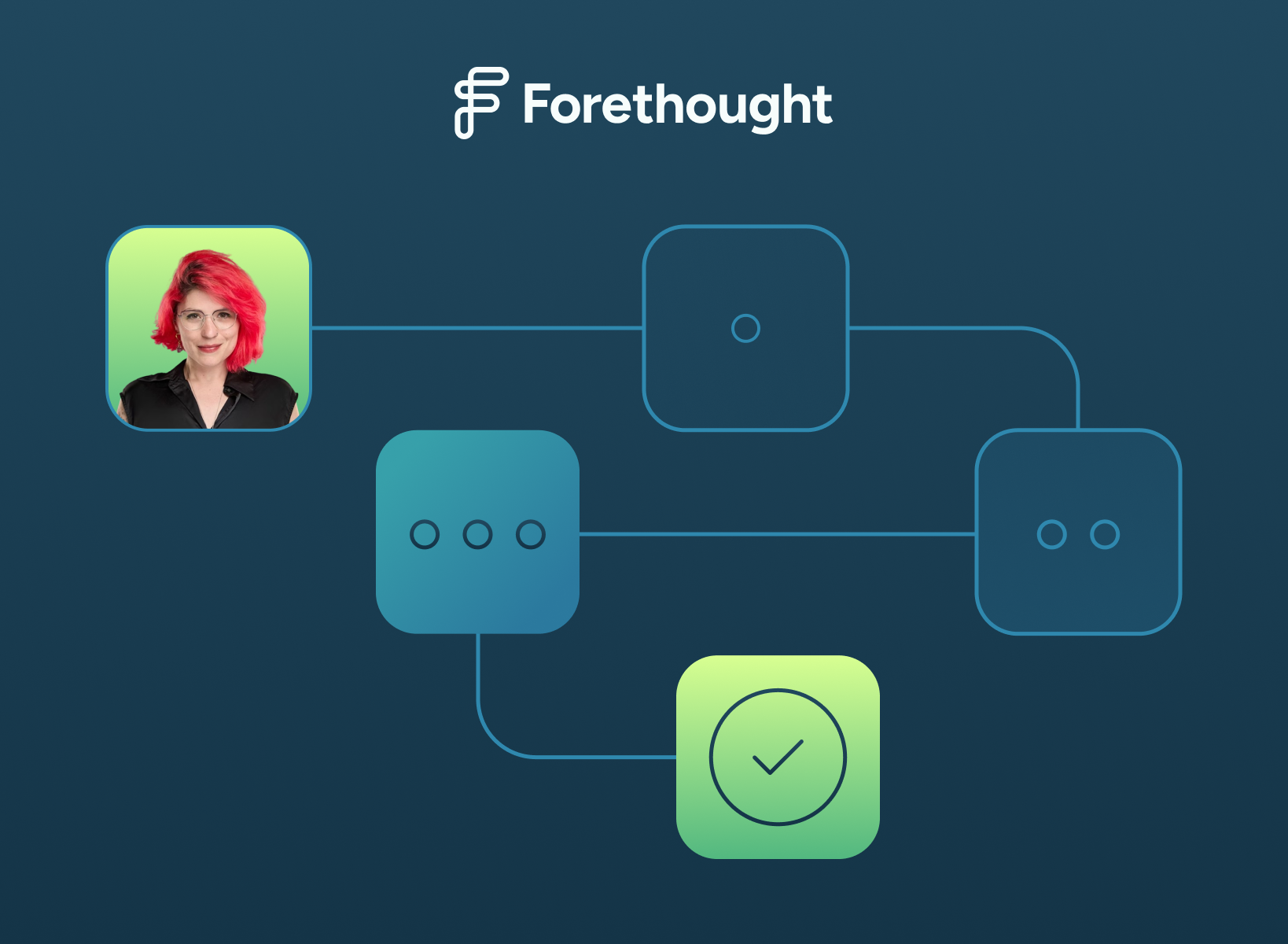Like most CX leaders, you’re probably under pressure to scale without adding headcount. At the same time, you’re expected to show measurable impact from your AI investments.
The problem is that the most common support metrics weren’t built to surface insights into how to scale with AI. They might be easy to track, historically expected by leadership, and tempting to rely on, but they often suggest actions that lead to more work for your team, not less.
If you’re serious about using AI to scale without hiring, you need to measure the right things. That means shifting focus away from activity-based metrics and toward outcome-based ones. The three metrics that matter—resolution rate, customer satisfaction, and cost per resolution—tell you whether your AI is doing real work, where automation is helping, and where your humans are still picking up the slack.
3 misleading vanity metrics (and why they fall short)
Some of the most common support metrics can give you the wrong impression about how well your team is scaling with AI because they measure the wrong thing for the goal at hand.
We’ve chosen examples like average handle time, ticket volume, and first response time because they’re usually easy to track and historically tied to support team performance. But when you use them to evaluate AI’s impact, reward changes that damage the customer experience.
1. Average Handle Time (AHT)
You’re used to tracking AHT to show how efficiently your team is working. It measures how long it takes an agent to resolve a ticket from start to finish, and it’s often used to justify headcount, identify bottlenecks, or flag coaching opportunities. So when AHT runs high, it’s easy to assume AI can help bring it down and that lower AHT means you’re scaling.
After implementation, AHT drops, which looks like a win, but speed isn’t the same as resolution. On the surface, AI might be helping with quick wins, but the complex issues that take more time might be getting less attention. Because you’ve focused your configuration on speed and ignored the quality of ticket resolutions, some customers return with follow-up questions and CSAT starts to slip.
AHT rewards fast closures, even when the issue isn’t actually solved. If you optimize around it, you risk encouraging shallow fixes that create more work later.
2. Ticket Volume
When ticket volume starts to climb, you know eventually your human team won’t be able to keep up. As you get closer to that threshold, resolution times slip, and burnout sets in. So you deploy AI to manage the extra load by automating responses to common questions.
But if you’re measuring success purely by the number of tickets AI touches, you can end up suppressing contact options or forcing customers through rigid automation flows just to protect volume metrics. Some tickets might get deflected before they should be, while others might appear “touched” by AI but still require the customer to take action on their own.
Meanwhile, AI might be working well in some areas, but if resolution isn’t tracked and if frustrated customers flood other channels it’s hard to see the real impact. To reduce volume meaningfully, you have to track whether issues were actually resolved.
3. First Response Time (FRT)
If you’re used to tracking first response time as a proxy for responsiveness, it’s tempting to turn to AI to bring that number down when it’s high because AI will always respond instantly. Maybe a chatbot greets every customer, or an assistant delivers a templated reply the moment a ticket is submitted.
Once implemented, FRT drops dramatically, often to near-zero. But once that happens, FRT stops telling you anything useful. It doesn’t measure whether the issue was resolved, whether the customer felt helped, or whether the automation actually reduced your team’s workload.
If FRT is all you’re tracking, you could end up reporting perfect responsiveness while customer satisfaction flatlines and agent load stays the same. Focus instead on whether the problem was solved and whether the customer walked away satisfied.
How to turn outcome-based metrics into a roadmap for scaling with AI
Speeding through tickets or deflecting more volume doesn’t necessarily mean you can take on more volume without headcount. If the quality of those interactions drops, or if customers end up needing more help later, you’ve just shifted the work, not reduced it.
The goal is to fully resolve issues with less human effort, while keeping customers satisfied. These three metrics—deflection or resolution rate, CSAT, and cost per resolution—give you a clear view into where automation is working, where it’s falling short, and what to improve next.
1. Deflection or resolution rate
Deflection rate tells you how many tickets are resolved without a human, which is not the same as how many tickets AI touches; and the difference matters. If your deflection rate looks high, but customers are still following up or switching channels to get real help, then nothing’s been resolved. In those cases, automation hasn’t reduced workload, it’s just delayed it.
High-quality deflection happens when AI can fully resolve an issue, end to end, without requiring a human or forcing the customer to take the next step. That’s typically only possible with agentic AI, which can take action on behalf of the customer instead of just suggesting next steps or pointing to help center content.
According to responses from over 600 CX leaders in our 2025 AI in CX Benchmark Report, companies using agentic AI reported the highest deflection rate across all industries: 44%, compared to 33% for non-agentic AI and 28% for no AI at all.
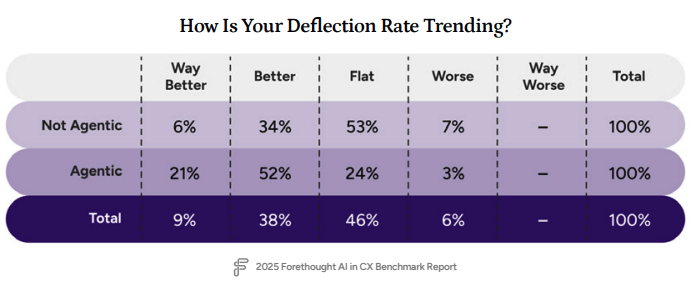
In one example, Forma, a flexible benefits platform, used deflection rate to guide their automation strategy as their membership base doubled. Instead of hiring to match demand, they implemented Forethought Solve, which uses agentic AI to fully resolve customer inquiries across chat and email. In one month, over 13,000 customers reached out and more than 5,000 were resolved through automation.
As their deflection rate rose from 30% to 39% in a short time, they gained clear, quantifiable insight into where automation was working. They also tracked satisfaction alongside deflection to make sure those resolutions actually felt like resolutions, and were satisfied when it stayed flat as deflections rose.
Grammarly took a similar approach—raising the bar for what AI support could deliver when they chose Forethought. From day one, their experience felt more accurate, more responsive, and more human, and the numbers backed it up: deflection rates have held steady at an impressive 87%.
A consistently updated knowledge base, thoughtful implementation, and smart API integrations helped Grammarly see results quickly. And by connecting Forethought deeply into their internal systems, they unlocked the ability to take meaningful action—not just answer questions—directly within their workflows.
2. CSAT or sentiment
Customer satisfaction is usually the final word on whether your support experience is working. It’s one of the clearest signals of whether your automation is resolving issues or just moving customers along, and when you’re trying to scale with AI, that signal becomes even more important as your team interacts with less customers directly
It’s important to focus on successful deflections, but at the same time, if customers walk away frustrated or come back for help again, you could be hurting satisfaction overall. Your deflection metric should be paired with a view into how customers felt about the interaction.
Our recent research found that CSAT tends to improve when AI is agentic because customers get a resolution to their issues in one interaction without being asked to take another step or repeat themselves.
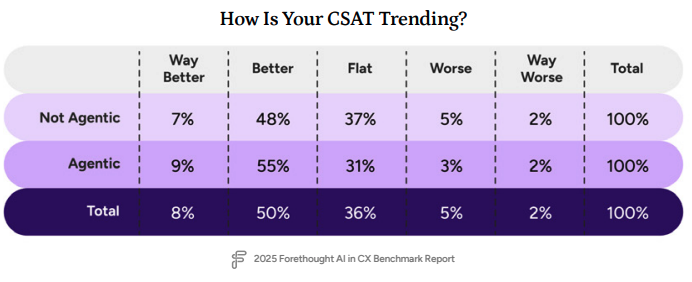
YAZIO, a leading nutrition and calorie tracking app, learned this firsthand. When they launched Forethought Solve, deflection quickly rose to 60%, but CSAT stalled at 3.1 out of 5. Instead of assuming the automation was working just because volume dropped, the team used CSAT to identify where the experience needed improvement.
They refined workflows and tuned the language. As a result, CSAT rose to 4.0, even as deflection climbed to 80%. That gave the team confidence that automation wasn’t just reducing volume—it was actually delivering resolution in a way customers appreciated.
3. Cost per resolution
Cost per resolution is primarily driven by human effort. The more work your agents have to do—triaging tickets, handling repeat issues, building manual workflows—the more each resolution costs. And the higher that cost, the less volume your team can absorb without growing headcount.
AI should reduce that cost by handling work humans don’t need to touch: repetitive questions, ticket classification, and early-stage data gathering, but not all automation does this equally well.
Our research found that 63% of companies using agentic AI saw resolution costs improve, including 11% who said costs were trending way better. Meanwhile, 62% of companies not using agentic AI said resolution costs were flat or rising.
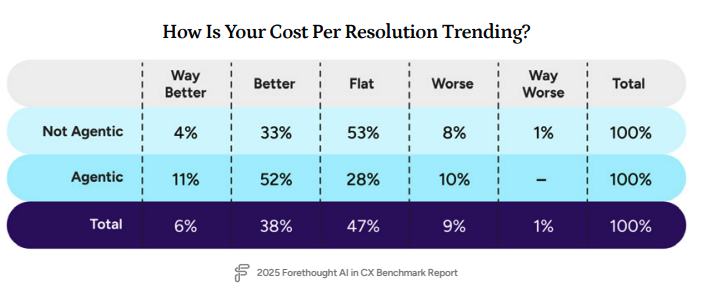
Achievers, an employee recognition platform, saw this play out firsthand. During peak seasons, over 20% of their tickets were repetitive tasks like password resets. They were all manually triaged, manually resolved, and costly to handle at scale. When they implemented both Solve to automate those resolutions and Triage to eliminate manual routing, they cut the effort per ticket significantly.
Their effort helped them avoid backfilling five agent roles, even as volume increased. That kind of result positively impacts cost per resolution and makes it a guide for whether or not AI is truly helping you scale.
Scale with hiring comes from AI that truly resolves customer issues
If your goal is to scale without hiring, the day-to-day metrics you’ve always tracked aren’t enough as stand alone guides. They tell you information about the work, but not its effectiveness.
You’ll be able to truly scale without additional headcount when the right issues are handled automatically, the complex ones reach your team faster, and your agents aren’t repeating work that AI should have resolved. Together, resolution rate, CSAT, and cost per resolution give you a complete picture of whether your support system is actually reducing effort or just moving it around.
Forethought is built to help CX leaders automate real resolution across channels, monitor performance where it matters, and scale support without compromising quality.
Request a demo today to talk to one of our experts about how to measure an effective AI program.
Hashtags blocks for sticky navbar (visible only for admin)
{{resource-cta}}
{{resource-cta-horizontal}}
{{authors-one-in-row}}
{{authors-two-in-row}}
{{download-the-report}}
{{cs-card}}




.svg)

.svg)
.svg)

.png)



.png)



